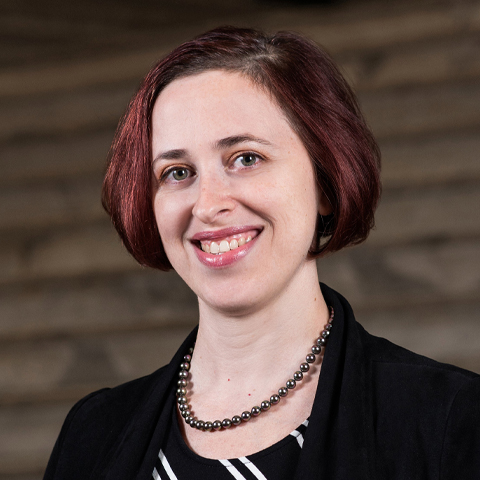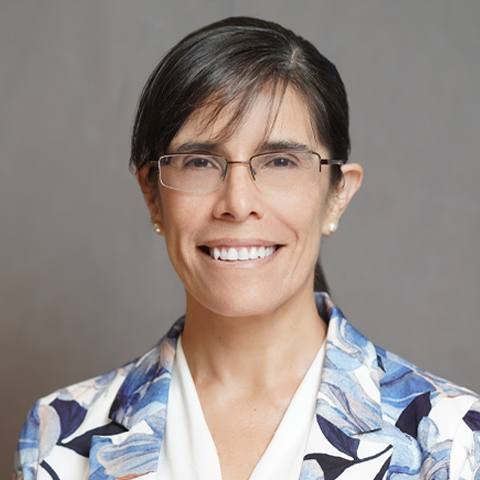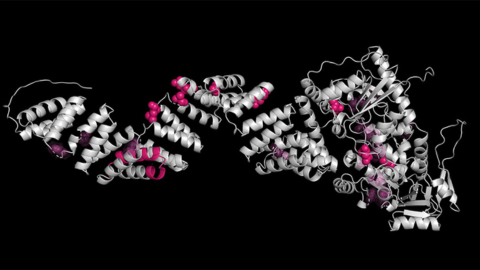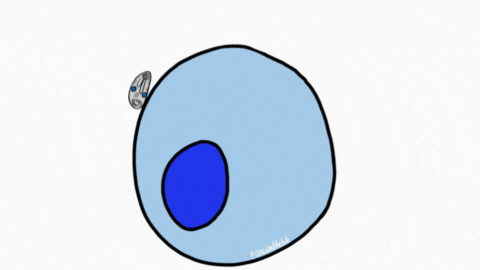
Illuminating the path to permanent residency
Natalie Chernets and Paola Cepeda each came to the U.S. to pursue a Ph.D. Now they both help international postdocs navigate the ins and outs of immigration.
Chernets, a Ukrainian-born scientist, came 15 years ago with her spouse, who could not obtain work authorization after completing his M.S. in the U.S.; they lived on a single paycheck for seven years. Cepeda came 12 years ago from Peru with her young daughter. It took Cepeda 11 years to obtain permanent residency. It took Chernets 13 years because she made a career change from electrical engineering to higher administration.

For highly skilled scientists like Chernets and Cepeda, the pathway to permanent residency can take a long time and requires many qualifications.
“That is basically what pushed us, both Natalie and me, to be advocates and work on this issue to support international postdocs,” Cepeda said. “Now that we know things, we wish we had known these things before, and it’s important that everyone knows this so that they can plan in advance, prepare and make the right decisions.”
Chernets and Cepeda are directors of postdoctoral affairs at Drexel University and Washington University in St. Louis, respectively, where they help international scholars with their immigration education.

“The biggest one that Paola and I experienced ourselves and see our trainees struggle with is the hidden curriculum: things that you don’t know until you face them,” Chernets said. Examples include career changes that can affect immigration ability, probationary periods, early employment termination and limitations on travel and job mobility.
For international postdocs, career and immigration decisions are inevitably connected.
“Planning a long-term career in the United States is always a struggle,” Cepeda said. “You need to navigate not only your science and not only your career professional development but at the same time all the immigration landscape of the United States as well.”
Even adapting to daily life in America can be overwhelming because cultural customs differ regarding issues such as health insurance, K–12 education, salaries and taxes.
Being informed and proactive
As co-principal investigators on a Career Guidance for Trainees grant from the Burroughs Wellcome Fund, Chernets and Cepeda recently developed the curriculum for a seven-week professional development program called Effective Career and Immigration Planning for International Scholars. They designed the program to illuminate the hidden curriculum and explain how career and immigration are coupled. Some career decisions can delay immigration, but being able to obtain permanent residency sooner can help a researcher get grants and apply for jobs without needing sponsorship.
They offered the pilot phase of the program to Drexel and Washington University postdocs from January through February. Each weekly workshop addressed a topic related to professional and immigration development.
The first workshop introduced and stressed the importance of an immigration portfolio. The documents in this portfolio show how an international scholar’s qualifications meet the immigration criteria for permanent residence and have a scientific impact.
“You have to justify yourself as a scientist, and to do that justification, you have to collect evidence,” Chernets said. “This collection of documents that serve as evidence of how extraordinary you are as a scientist actually highlights the importance of your career planning and professional development planning and has a huge impact on your eligibility for potential permanent residency in the U.S.”
More information about the immigration portfolio can be found in an Inside Higher Ed article that Cepeda and Chernets wrote in 2022.
Among the familiar documents in the portfolio is a research publication, but Chernets and Cepeda want to highlight lesser-known types of evidence. For example, scholars can collaborate with their institution’s communication team or media office to promote their scientific manuscripts by creating a news articlethat is more accessible to the public, highlighting the impact of their research and, in turn, their work as scientists.
Chernets and Cepeda hope to motivate scholars to be proactive in the immigration journey.
“The purpose of this program is to really provide actionable recommendations and accountability,” Chernets said. “Every week, you have an opportunity to set your own goals and act on them, and you learn different ways to take advantage of opportunities that can strengthen both your career and immigration portfolio.”
Pilot participants have reported that the program equipped them to handle tasks related to career and immigration planning, such as building a professional brand and setting short-term goals as part of their immigration strategy.
“The results of our pilot are very promising,” Cepeda said.
One of their next steps is to adapt this curriculum into a one-day boot camp that can be offered at conferences, which would help international graduate students and postdocs from schools beyond Drexel and Washington University.
“I would like to think about this course as learning how to do a two-for-one deal,” Cepeda said. “You already know that there are some things that are going to make you very valuable in the job market if you are a scientist, for example, having publications and awards, or having a presence in the media … but you could also use that [evidence] again to make you eligible for permanent residency.”
The program provides education and sheds light on many topics postdocs may not have considered before. However, it is not a substitute for legal advice. Attorneys are still needed, as immigration regulations are complex and can quickly change over time. An immigration attorney comes in for one workshop as part of the Effective Career and Immigration Planning for International Scholars program to discuss legal options and complexities pertaining to permanent residency.
Others have a responsibility too
Chernets and Cepeda have given presentations about international scholars in the U.S., as well as their work in immigration advocacy, at several national conferences. A National Institutes of Health advisory committee invited them to speak at a listening session on re-envisioning NIH-supported postdoctoral training. At all these events, they highlight the importance of integrating immigration education into postdoctoral training.
Their program educates postdocs on what they can do themselves, but Chernets and Cepeda believe institutions and other organizations have a responsibility to advocate for immigrant scientists as well.
“Institutions also play a role in thinking about the policies that they have … that may be negatively affecting postdocs inadvertently,” Cepeda said.
For instance, Chernets mentioned that an institution’s career services, which serve all postdocs, may provide generic advice that does not take immigrant-specific situations into account. International offices will address immigration questions, but they may only consider government compliance.
“Professional scientific societies also have the responsibility to advocate for these postdocs and maybe create collective efforts to change things,” Cepeda added. Supporting qualified postdocs helps the U.S. maintain its leadership in fields related to science, technology, engineering and mathematics.
International postdocs can be better supported if faculty and institutions are educated on how postdoc appointments affect immigration status and other aspects of an international scholar’s daily life, especially because people who are not on visas are usually not aware of this problem. For instance, Cepeda said, if a postdoc has a one-year contract, then the postdoc’s immigration status, driver’s license and documents associated with their dependents may also be good for only one year.
Institutions should work with their immigration experts to explore what options they may have. “One could be to offer longer contracts for postdocs so that their documents can also be longer accordingly,” Cepeda said. “Another one could be to separate the length of the initial appointment from the length of immigration status if there is an intention on all parts to continue the appointment after the initial period comes to an end.”
As the international officer for the National Postdoctoral Association, or NPA, Cepeda spearheaded the development of the NPA’s Guide to International Postdoc Onboarding, which helps directors, administrators and faculty understand the unique challenges international postdocs face and how they can provide better support.
Final advice
Chernets and Cepeda believe in a supportive environment — having people to talk to about the challenges and lengthy process of immigration can be helpful. Also, postdocs need to educate themselves so they can learn to advocate for themselves effectively, particularly with potential U.S. employers. Lastly, when seeking advice from others, international students and postdocs should verify this advice with trusted immigration attorneys or officers; immigration policy has many nuances and many factors that may or may not change over time.
Enjoy reading ASBMB Today?
Become a member to receive the print edition four times a year and the digital edition monthly.
Learn moreGet the latest from ASBMB Today
Enter your email address, and we’ll send you a weekly email with recent articles, interviews and more.
Latest in Careers
Careers highlights or most popular articles

Upcoming opportunities
Friendly reminder: May 12 is the early registration and oral abstract deadline for ASBMB's meeting on O-GlcNAcylation in health and disease.

Sketching, scribbling and scicomm
Graduate student Ari Paiz describes how her love of science and art blend to make her an effective science communicator.

Embrace your neurodivergence and flourish in college
This guide offers practical advice on setting yourself up for success — learn how to leverage campus resources, work with professors and embrace your strengths.

Upcoming opportunities
Apply for the ASBMB Interactive Mentoring Activities for Grantsmanship Enhancement grant writing workshop by April 15.

Quieting the static: Building inclusive STEM classrooms
Christin Monroe, an assistant professor of chemistry at Landmark College, offers practical tips to help educators make their classrooms more accessible to neurodivergent scientists.

Unraveling oncogenesis: What makes cancer tick?
Learn about the ASBMB 2025 symposium on oncogenic hubs: chromatin regulatory and transcriptional complexes in cancer.

